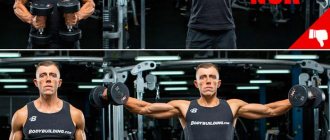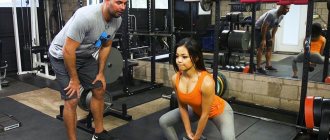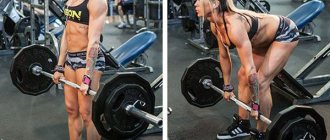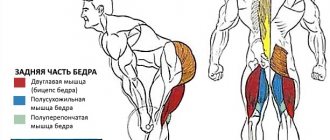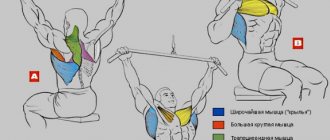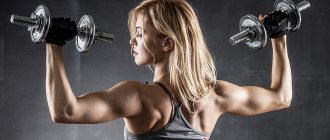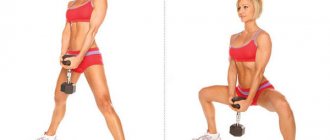Working muscles
Answering the question of which muscles work when performing a deadlift with dumbbells, it is worth noting that almost the same muscle groups are involved as in the classic version of a deadlift with a barbell.
Did you know?
Bodybuilders undergo rigorous drying of their bodies before competitions. At the time of the competition they have at least 5% subcutaneous fat. It is worth noting that at 3% fat mass death occurs.
Basic
Works the lower back, gluteal muscles and hamstrings. At the same time, comparing the exercise with dumbbells and with a barbell, in the first option the work of the forearms is minimized, since the weight of dumbbells is significantly lower and it is easier to hold them in your hands. This can be considered an advantage, because often performing deadlifts, athletes are more focused on the process of holding a heavy barbell, instead of monitoring the technique of the training process. The load on the lumbar region is also reduced. It works, but not to the same extent as with a barbell deadlift.
Additional
Additionally, the work includes the teres major dorsi, rhomboid and trapezius muscles, rectus abdominis, latissimus muscles and spinal extensor muscles. All these muscle groups are actively worked out and receive a good workout.
Tips and tricks
1) Dumbbells help place your arms in a more natural position; the joints are less loaded, since they occupy a more comfortable position, due to the fact that there is no rigid fixation like in a barbell.
2) With dumbbells you can increase the range of motion; they allow you to bend lower and make the exercise more effective, if, of course, the flexibility of your joints and muscles allows it.
3) Dumbbells are suitable for girls and beginners, since experienced athletes have trouble finding a large weight adequate to the working weight with a barbell.
4) Before starting the exercise, your back must be straight and only slightly arched in the lower back; if you cannot do this, then bend your legs more or bend less, at the top straighten to the end so that your torso takes a strictly vertical position.
5) When performing the exercise, know that if you bend your legs strongly, the gluteal muscle will be more involved in the work; if, on the contrary, you bend them less, the lower part of the thigh biceps will be more involved in the work. You should not do the exercise with absolutely straight legs; it will overload the hamstrings. It is ideal when at the lowest point the distance from the knee to the buttock is slightly higher than parallel to the floor.
6) If you want to feel and load your buttocks well at the same time as training your back, first do lunges or deep squats until they are parallel to the floor.
7) If you have problems with the lower back, first strengthen it with hyperextension; strengthening the abdominal muscles will not hurt, and be sure to warm up and stretch.
Number of approaches and program
Each athlete determines the weight and number of repetitions for himself. As for the quantity, for beginners on average you can do 3-4 sets of 8-12 repetitions. Less than 8 repetitions will not bring results. The weight of dumbbells for beginner men can be 10-15 kg each, for women – 5-7 kg each. It is worth repeating that lifting heavy weights when deadlifting with dumbbells on straight legs is not recommended. The weight of the dumbbells should be increased gradually.
Deadlift with dumbbells: execution technique
If you have ever performed a “deadlift with a barbell,” then you will not have any difficulties at all, because in terms of technique with a barbell/dumbbells, as I already said, there is no difference.
But, if exercises are new to you, then carefully study the recommendations below...
1/ We take dumbbells in our hands (there is no need to chase the weight, take a light one, you will progress when you learn the correct technique, the “feeling” of the working muscle), and stand straight, while doing this:
- We hold dumbbells near each leg;
- The back is straight, we don’t slouch;
- The gaze is directed forward, not up or down, but strictly forward at yourself, as if you were looking in a mirror;
- Place your legs as comfortable as possible (the guideline is slightly narrower than shoulder width), feet parallel to each other.
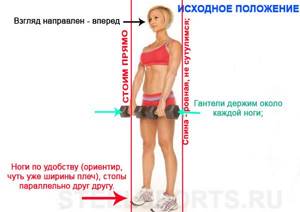
2 / From the starting position (see photo above), you need to lean forward (down) as low as possible (definitely, the dumbbells should be below your knees), while keeping your back straight (fixed).
Note:
- When lowering (tilting) down and when lifting from the bottom position up (back to the starting position), you should always “slide” the dumbbells along the front surface of the thigh.
- When bending down, you must simultaneously bend your knees slightly (just a little, you don’t need to bend them too much, otherwise it won’t be a straight-legged deadlift, but a regular squat), and pull your pelvis back (as if you want to touch your buttocks to an imaginary “ wall").

At the bottom point, hold for 2 seconds, feeling a burning sensation in the back of the thigh and return back to the starting position, then repeat everything again, as many repetitions as you need.
As for the number of approaches/repetitions, cheat. in the articles: “repetitions”, “approaches”. In short, for the vast majority of people, I would recommend 3-4 working sets in the 8-12 rep range.
By the way, there is another very interesting variation of this exercise:

Here, in terms of the technique of execution, everything is the same, however, in addition to the fact that there is a lowering (tilting) with the body down towards the feet, one leg is also moved back at the same time.
Otherwise there is no difference in technology. In my opinion, it’s a difficult exercise, you need to keep track of a lot, it’s definitely not for beginners... but I couldn’t tell you about it, when you grow up, try it.
Deadlift technique, how to do Romanian deadlifts correctly
The straight-legged deadlift is considered a less complex exercise, from a technical point of view, compared to the classic version of the deadlift. However, it involves a significant load on the spine and is very demanding on the level of stretching of the athlete. Therefore, before starting the class, you must warm up, paying special attention to the joints and ligaments of the lower body.
Before you begin performing deadlifts, it is recommended to spend a few minutes on hyperextension - this way the back muscles will prepare for the upcoming load.

nnn
To get into the starting position for the deadlift, place your feet shoulder-width apart. This distance can be varied depending on the goals of the exercise: a narrower position will involve the buttocks more, but if you place your feet a little wider, the emphasis will shift to the hamstrings. Legs stand firmly on the floor, feet parallel. The back is tense, the natural deflection in the lower back is clearly recorded. The head is in line with the back. This body position should be maintained throughout the entire exercise.
The barbell is positioned on the floor so that the bar is above the feet. If there is a need to minimize the load on the lower back, you can take the projectile not from the floor, but from a special rack.
- While maintaining the above-described back position, you need to take the bar with an overhand grip slightly wider than shoulder width.
- As you inhale, moving your buttocks back and slightly bending your knees, tilt your body forward. The natural arch in the lower back is preserved. You need to bend over as far as the stretch allows, until maximum tension in the back of the thighs. The beginning of the rounding of the back is a signal to complete the tilt: this will be the lowest point.
- After a short delay in the lower position, we begin to exhale and lift the body up. The lift continues until maximum tension in the back and buttocks. As your legs straighten, you need to move your shoulders back so that your shoulder blades move towards each other.
- You should fixate at the top point, maintaining tension in the target muscles. There is no need to fully extend the body. During the pause, the shoulder blades remain retracted, the lower back is slightly arched, and the center of gravity falls on the heels. The pelvis, shoulders, and ankles should be on the same vertical line.
The exercise is performed in 3-4 sets of 10-12 repetitions each.

Mmm
There is another version of the breathing technique while performing deadlifts, in addition to the one described above. At the beginning of the tilt, a deep breath is taken, the tilt itself is performed while holding your breath. The upward movement is done while exhaling (as a rule, it accompanies the passage of the most difficult section of the climb).
Important nuances: what you should pay special attention to
The apparent simplicity of performing this type of deadlift is deceptive. To master the correct technique, you need to consider a number of points:
- Experienced athletes recommend doing this exercise in shoes with flat and wide soles, in which there is almost no heel. It should fit snugly on your leg.
- All movements are performed in a shortened amplitude. It is important to catch the moments of maximum tension on the back of the thighs at the lowest point (usually the bar at this moment reaches the middle of the shins) and the lifting of the upper body (without fully straightening the back). Deadlift involves moving up and down between the lowest and highest points with a short fixation in them.
- Despite its name, the straight-legged row involves bending your knees slightly. Lowering the apparatus on straight legs entails a rounding of the back; in addition, slightly bent knees force the leg muscles to additionally engage in work, which protects the joints from excessive load. Therefore, you need to keep your knees slightly relaxed - this position is called “soft knees.”
- An indispensable condition for correct technique is control over the position of the back. Throughout the entire exercise, it should remain unchanged, with a fixed natural deflection. This is easier to do by watching your shoulder blades. When they begin to move apart, the back rounds.
- The barbell must be raised and lowered in a symmetrical manner. Transferring part of the load from one half of the body to the other is unacceptable.
- When performing a deadlift, the bar moves up and down strictly along the shins, the fingers practically slide along the legs.
- The effectiveness of the deadlift directly depends on the presence of the brain-muscle connection. The exercise requires high concentration and focus on the work of the target muscles. It is important to feel the tension at all stages of the movement. Mechanical execution will not give the desired result.
Video: straight-legged deadlift technique
Video of straight-legged deadlift technique for women and men
Possible technical errors
If the correct technique is not followed, the straight leg deadlift turns from an effective exercise into a traumatic one. The most common mistakes are:
- Rounding the back. This movement greatly increases the load on the spine and can cause injury.
- Pulling the barbell forward from the body. This overloads the lower back and increases the risk of back injury.
- Changing the angle of flexion of the legs at the knee joints at the middle and lower point of movement: it should remain unchanged.
- Excessive straightening and hyperextension of the body at the top point, which has a destructive effect on the spine.
- Perform the exercise with absolutely straight legs. Don't forget about "soft knees".
- The weight of the projectile is too high. The priority when performing deadlifts is perfect technique, not weight records.
- Involving hands in work. In this case, their role is limited to holding the projectile, and nothing more.
To avoid technical errors and to control the execution of each movement, the deadlift should be done in front of a mirror (we stand facing it, not sideways, so as not to cause an imbalance by turning the head). Until the correct technique is mastered, you should work with minimal weight. The above errors are shown in the photo below.
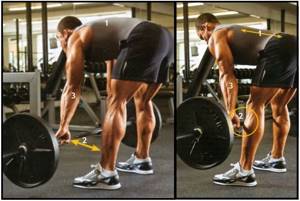
Mmm
Romanian straight leg deadlift
When performing an exercise like the Romanian barbell deadlift , the key is to keep the hamstrings under constant tension . This method of execution is preferred to be done with dumbbells. The main condition of the Romanian deadlift is that the buttocks should be pulled back. When the movement is performed, the buttocks move backwards off axis. When performing the Romanian deadlift, an important stage of the exercise is to lower the barbell not to the floor, but to the level of the middle of the shin in order to eliminate the back and also reduce the risk of injury to the spine. The bar, relative to the working position, does not move forward or backward. When lifting, we focus on our legs.
With the Romanian deadlift, you not only develop your hamstrings and glutes, but also hamstring flexibility. At the top point of the amplitude, the body position should be tilted slightly forward. When choosing the placement of your hands on the apparatus during the exercise, you do not need to adhere to any special recommendations, but use the placement that will be the most convenient and comfortable. The benefits of using this exercise for girls are observed in good shape and improved shape of the leg muscles.
Execution technique
The main points when performing this exercise are:
- You need to look in front of you, the shoulder blades of your back are brought together, bend your lower back forward;
- The arms are straightened along with the working bar, the palms are on the apparatus with an upward grip shoulder-width apart, the legs should bend slightly at the knees and are shoulder-width apart, the feet are parallel to the direction strictly forward;
- The bar slowly lowers with a minimum distance to the body, the torso drops lower. The bar is lowered to the level of the knees, the chest is blown forward and the shoulder blades are together;
- At the lowest point, you need to stay in this position to feel the tension in your hamstrings and buttocks. The body lowers parallel to the floor, without stopping we lift it back up, straightening the body to its original position.
This exercise is ideal for engaging the front of your thighs. The load should be on the legs , and not pushed with the efforts of the hands.

